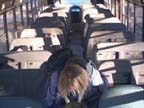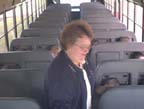Caught on Tape

Spencer Community School District, in northwestern Iowa and serving more than 2,400 students, is one of the fortunate districts; not a single fatality has been recorded despite the dozens of motorists who made a habit of illegally passing school buses. The district’s transportation supervisor, Dan Schultz, intends it to stay that way.

Around stopped bus
Schultz heard the bus drivers’ complaints of passing motorists, but didn’t know how to prove these violations were occurring. He knew there must be a solution and began researching video technology that would record stop-arm violations – irrefutable evidence of breaking the law.Schultz was especially concerned about stop-arm violations occurring around the bus that carried Spencer’s 3- and 4-year-old vulnerable preschoolers. With the blessing of the Iowa Pupil Transportation Association (IPTA), the Iowa Department of Education purchased one VHS-based analog video recording system for Schultz to use on the preschool bus. The camera was mounted on the inside of the bus facing outward, and recorded drivers who passed illegally.
When a stop-arm violation occurred, bus drivers would say the car’s license plate number out loud, describe the vehicle and make note of any witnesses, all of which was recorded through the system’s audio input. The driver would then report the violation to Schultz, who filled out an incident report. Schultz then turned the case and the video over to the police, to further investigate the violation and identify the offender.
In a six-month trial period with one camera installed on the pre-school bus, 40 drivers were caught, and all but three pleaded guilty after viewing the tape. The local newspaper and radio station reported on Spencer’s new recording system, and drivers took notice. In the second six-month recording period, only four drivers were caught passing school buses.
Schultz credits the Spencer Police Department for being so cooperative and accepting the additional investigation work on top of their regular responsibilities.
“The Spencer police have become our partners,” Schultz said. “We tape the violations, hand them to the police and they take care of the rest. We know they are committed to student safety as much as we are.”
Schultz found that one of the major benefits to recording the stop-arm violation was the tangible proof the tape offered. In all but a few instances, drivers confessed immediately upon seeing the tape. Their early confessions saved time and money by not going to court.

Video evidence
“It’s nearly impossible for drivers to talk their way out of a stop arm violation,” Schultz said. “We have it on tape – you can’t dispute video evidence.”In one instance, authorities discovered that one of the caught individuals was not allowed to walk outside because of his medication, let alone drive a car. Another individual, who had repeatedly gotten out of stop arm violations by accusing the bus driver of entrapping his car, was finally found guilty after he viewed the tape and confessed.
Though the VHS system had been successful at catching stop arm violators, its image quality proved problematic at times; and without a date and time stamp, Schultz and his drivers had to search through hours of footage to find the passing motorist. The transportation department went through 40 videotapes in six months; when a tape contained a suspected violation; it could not be re-used until the trial date.

Going digital
Schultz decided to upgrade, and purchased a digital recording system: the Digital Chaperone by Honeywell (Syossett, N.Y.). The new system provided crisp, clear images, the ability to e-mail photos to police and to focus in on various points. The system also allowed for multiple cameras to record continuously.Each bus has three cameras: one camera faces forward, recording any stop-arm violations; and two face backward, recording the students aboard the bus. Of the two cameras facing backward, one is located near the rear and one near the front to record the driver and student audio.
The digital system provided several additional benefits over the VHS-based analog system. Schultz could access the video cameras at any time from his laptop computer. Instead of scanning through hours of videotape, he and his drivers could pinpoint the incident. Images were recorded with the vehicle identification, date, time, camera name and various status inputs, which allowed for more accurate investigations.
The system also came with BusView software that allowed Schultz to find, print, distribute and archive video and audio files. Schultz found the ability to e-mail images to police and school administration among the most useful features of the digital system, as it sped up the investigation process.
“Spencer’s administration has been extremely supportive of the new digital system because they can actually see incidents occurring on tape when I e-mail them the still photo or video,” said Schultz. “Seeing is believing, and they’re glad to help remedy our passing motorist problems.”
Schultz also uses the system for bus driver evaluations, and credits it for saving valuable time. He has been able to make sure bus drivers are following protocol at railroads and intersections, information he may not have been able to gather during a supervised ride-along.
“I used to ride along with each bus driver as part of their review, which took a total of 32 hours – almost an entire week’s worth of work,” Schultz said. “Now I can pick random days to check in on each bus, which only takes 15 to 20 minutes per driver.”
The system also featured triggers that monitor driver inputs, such as stop arm use, brakes, speed, turning and warning lights. By reviewing the footage around the specific incident, police could determine whether the driver was performing correctly. If the stop arm was not deployed as it should have been, the suspected stop-arm violator could not be prosecuted.
Identifying bus stop and route improvements was an unexpected benefit of the recording system, Schultz said.
“After reviewing footage, I was able to make recommendations for moving some bus stops farther from busy street corners,” Schultz said. “This gives drivers more notice, so they’re more likely to stop an appropriate distance behind the bus.”
Success spreads
Because of Spencer’s success using a digital video recording system, the Iowa Pupil Transportation Association is in talks about expanding the program. The goal is for each school district to be able to have a similar video system. The state currently owns eight systems – six VHS and two digital – that are shared among districts that use them for the year. Schultz, who is also the president of the IPTA, said that although the digital system is a pricier option, its benefits far outweigh those of the analog system.“With an analog system, you’re stuck with what you’ve got,” Schultz said. “Digital systems allow you to expand and upgrade as your needs increase. Going digital makes sense for the future.”
These days, things are quieter – less hurried – for Spencer. Schultz is proud to say that the district has never had a two-time violator, and because of this, he knows the system is working. While there were 40 violations in the first six months of system use, there were only four the remainder of the year.
For school districts considering a stop-arm violation reduction program like Spencer’s, Schultz recommends getting all parties on board before buying.
“Bring in the authorities before starting your program, and explain that you want open lines of communication. Explain how the community benefits from a program like this,” Schultz said. “The cornerstone of the project is still the investigations into violations, so the police department must sign on for the added responsibilities.”
Now, when Spencer replaces an older school bus, the new bus is outfitted with a digital system.
“It’s not just about the safety of one child during one incident,” Schultz said. “It’s about protecting all of our students, and preserving the safety of all children.”
Looking for a reprint of this article?
From high-res PDFs to custom plaques, order your copy today!


